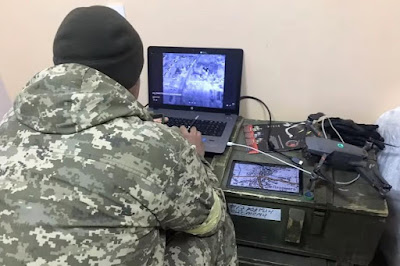The Internet has been down in the city of Mariupol since March 2. If there is a Starlink terminal there, it is still online.
 |
Ten Starlink satellites serving Odessa through ground
stations in Turkey, Lithuania, and Poland |
Last week I wrote about the arrival of a truckload of SpaceX Starlink terminals in Ukraine and their potential value to government and resistance leaders. A lot has happened in the ensuing week -- this is an update.
Last week, using Mike Puchol's Starlink tracking service, I found that users in Kyiv would have 100 percent uptime with connections through as many as nine satellites to ground stations in Turkey, Poland, and Lithuania. When the Turkish ground station was unreachable it dropped to as few as five, but uptime remained 100%.
I've since used his service to check connectivity snapshots in three geographically dispersed cities -- Odessa, Lviv, and Kharkiv. I always found between seven and ten satellites in service in Odessa and Lviv and between two and six in Kharkiv. This is not surprising since Lviv is west of Kyiv, hence closer to the Polish and Lithuanian ground stations, Odessa in the south is closer to the one in Turkey and Kharkiv is to the east -- near Russia.
 |
| Starlink Speedtest in Kyiv |
Puchol's simulation mode shows there should be 100% availability throughout the country at all times and, since there are few terminals, performance should be good. That was confirmed by an OOKLA Speedtest run by Oleg Kutkov in Kyiv. During the third quarter of 2021,
OOKLA observed median upload and download speeds of 87.35 and 13.54 Mbps in the United States and as shown here, Kutkov observed much faster download speed and similar upload speed. The Kyiv test showed a "ping" time of 75 ms compared to a median "latency" of 44ms reported by OOKLA. I'm not sure if their reported "latency" is one-way or round trip. If the latter, they are comparable,
There have been several software updates since last week. Most importantly Elon Musk tweeted that
SpaceX had enabled roaming in Ukraine so anyone with a terminal can transmit for a while then turn it off and move to another location or, if necessary, can remain online in a moving vehicle. In the same Tweet, Musk announced that they had reduced peak power consumption so the terminal could be powered by a car cigarette lighter. (There must have been some performance hit).
Musk also tweeted that "Some Starlink terminals near conflict areas were being jammed for several hours at a time" and they were bypassing the jamming with a software update. He added that he was curious to see what they tried next -- this sounds like "whack-a-mole."
It's noteworthy that in our "software-defined everything" world, SpaceX can make significant changes to the constellation with a software update. (The downside is illustrated in an
over-the-air software hack of ViaSat modems).
Musk warned that Starlink terminals could be targeted and advised users to turn them on only when needed, to place an antenna as far away from people as possible, and to cover it with light camouflage. He also
tweeted that some governments (not Ukraine) had asked him to block Russian news sources, but, as a "free-speech absolutist," he refused to do so.
In related news, Anonymous
has declared cyberwar on Russia and there are Telegram channels for IT professionals in support of Ukraine, one of which is English-language.
Finally, there was also a PR tweet by Ukraine's famed heavyweight champion boxers
the Klitschko brothers posing with a couple of Starlink terminals.
Some Musk critics see his disaster-relief efforts or delivering terminals to Ukraine as publicity stunts of little practical value. Starlink terminals in Ukraine are terrific publicity, but they are also valuable tools for communication by political and resistance leaders if they are unable to safely access the Internet or it is blocked. For example,
it has been reported that Mariupol is without electricity and water, and the Internet has been down since March 2. If there is a Starlink terminal there, it is still online.
Update 3/10/2022
Fifty of the square-antenna terminals from the second shipment
have gone to the DTEK Group. Half of them will be used for support of Ukrainian energy infrastructure and half will go to DTEK businesses.
Click here for more on DTEK's war effort
Update 3/17/2022
The Internet in the port city of Mariupol has been down since March 2 and the city is reported to be without electricity, gas, and water. If there are any Starlink terminals in the city, they should have no trouble getting online. I've periodically checked connectivity there and found between two and six satellites in service. (The rare time it got down to two satellites, the connection was through the Lithuanian ground station).
 |
| Six satellites in service over Mariupol |
Update 3/19/2022
From the Washington Post: "A person familiar with Starlink’s effort in Ukraine, speaking on the condition of anonymity to discuss sensitive matters, said there are more than 5,000 terminals in the country. We'd seen pictures of three truckloads before, but this is a whole new level. Enough for armed forces,
infrastructure companies like DTEK, NGOs, and government leaders.
Update 3/26/2022
Update 5/5/2022
As predicted, Starlink has become
an important government asset.
This article shows some of the ways Starlink terminals are being used.
The article is in Ukrainian, but the Google and Microsoft Translations are perfectly readable.
https://






![]()


![]()


![]()

![]()